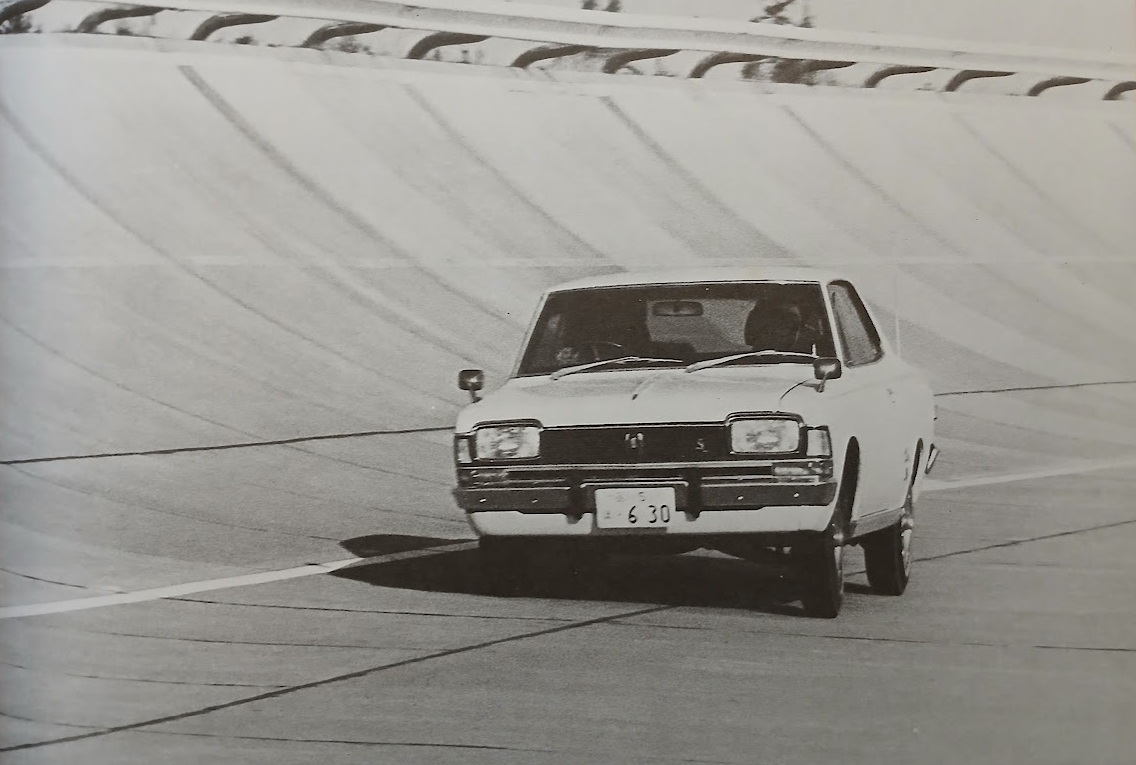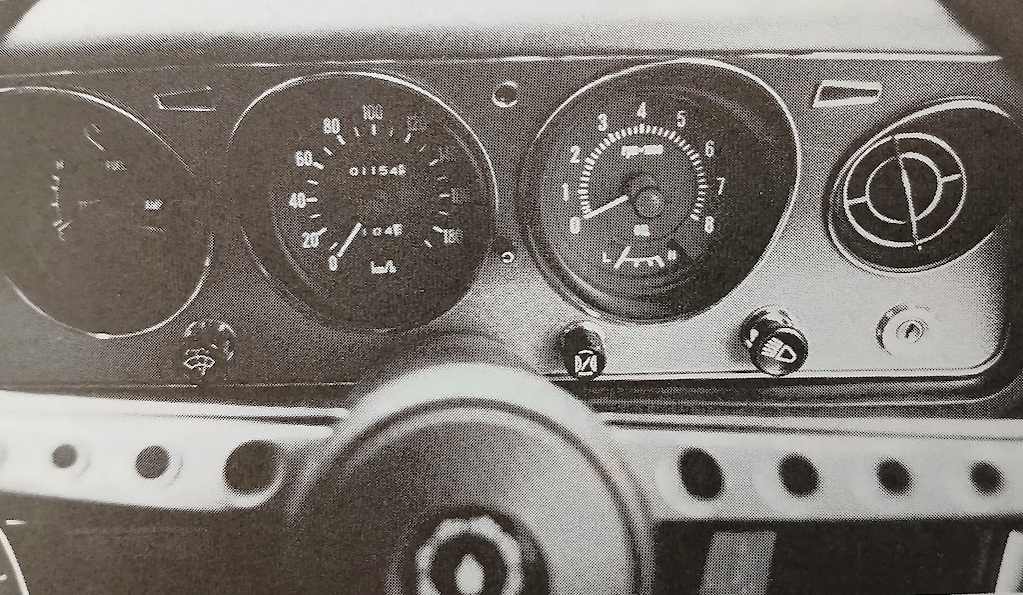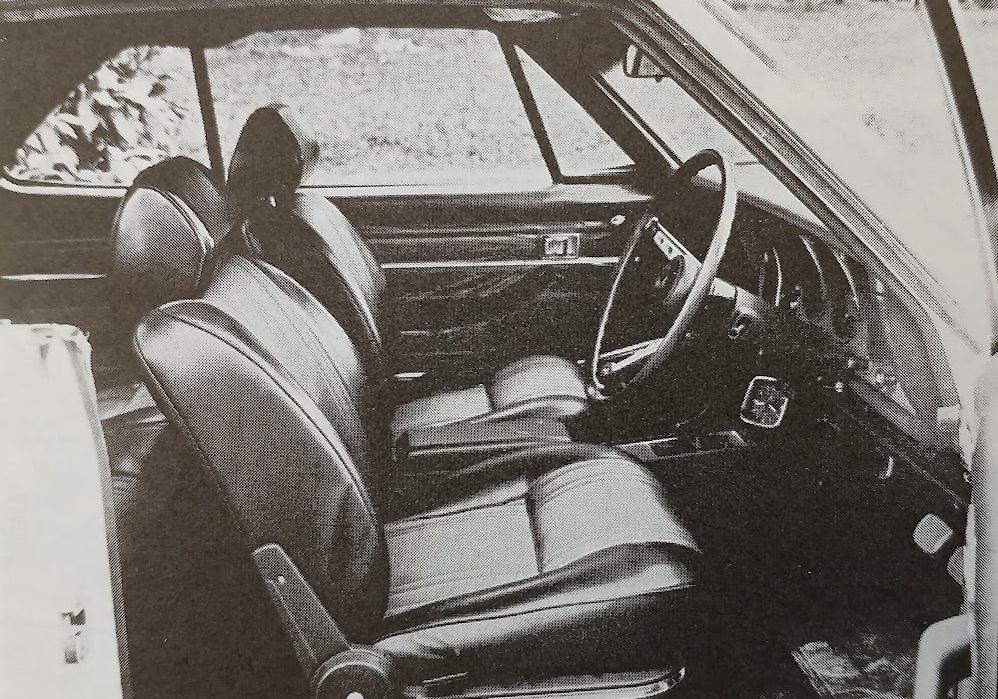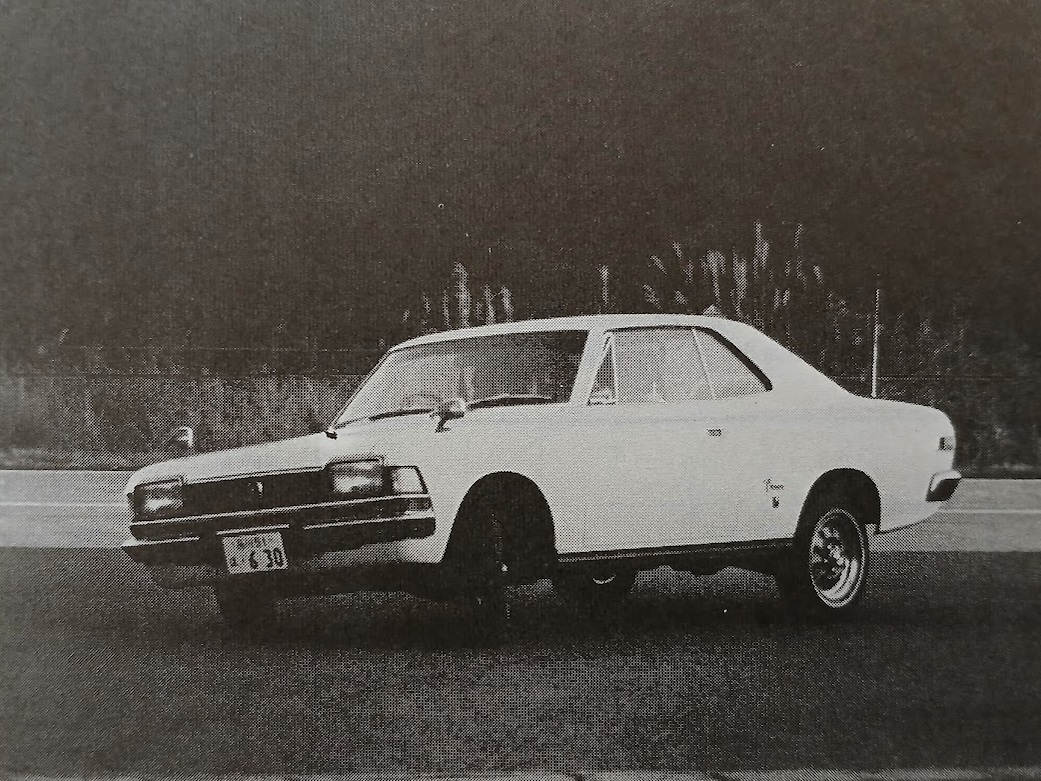Toyota Crown Hardtop SL (1969)
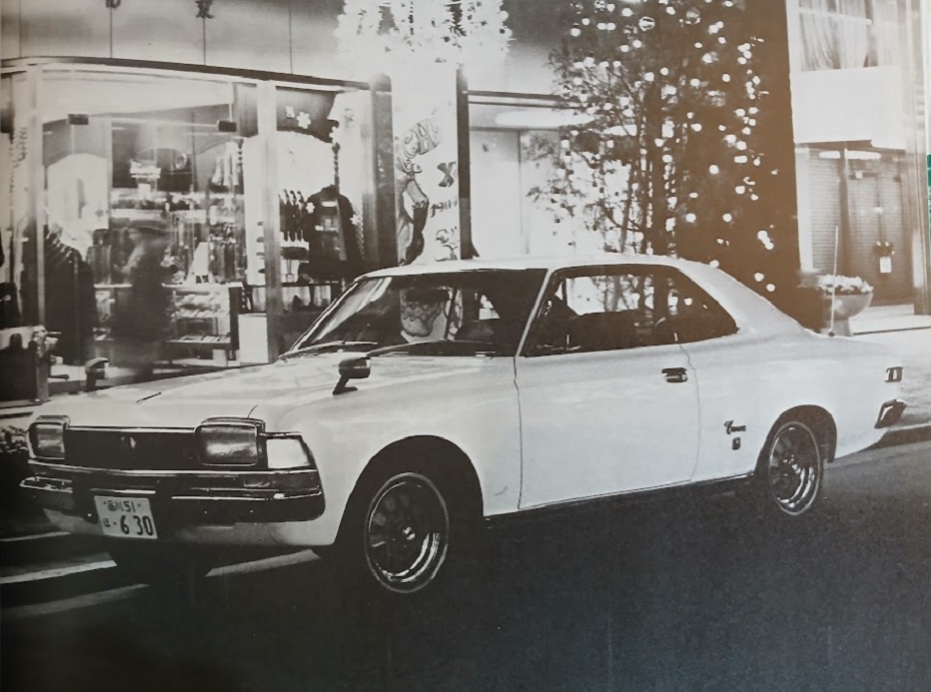
Publication: Car Graphic
Format: Road Test
Date: February 1969
Author: “C/G Test Group” (uncredited)
Summary: Two-door coupe version of the Crown S. Rear seat comfort is not compromised, six-cylinder SOHC engine revs easily to 7000rpm or more, extremely quiet up to high speeds, conversation is possible at 120km/h, brakes are powerful but require excessive pressure, steering is heavy at low speeds, ride is generally good but a bit stiff on bad roads.
Road testing the Toyota Crown Hardtop SL
Recently, white Crown S sedans have become a common sight on the streets, usually with middle-aged drivers who are likely the cars’ private owners at the wheel. Toyota, ever quick to recognize trends and seize an opportunity, announced a hardtop model of the Crown on November 1 last year, aimed primarily at middle-aged car enthusiasts and fashionistas. In Europe, most high-end six-cylinder sedans, such as the Opel Commodore and Ford Taunus, also come in coupe versions, but this Crown is the first domestically produced 2-liter coupe model.
The Crown Hardtop is a model with a fashionable hardtop coupe body mounted on the same perimeter frame as the sedan. The roofline is 25mm lower than the sedan, and the overall length is slightly shorter. The front end styling also gives a different impression from the sedan, with rectangular headlamps and large sidelights that wrap around to the sides. The hardtop comes in two types: the standard model and the sporty SL. The SL is equipped with the same M-B type engine (twin SU carburetors, 125ps/5800rpm) as the Crown S, has a firm suspension, and is equipped with standard front servo-operated disc brakes. Two transmissions are available: a four-speed floor shift and a three-speed Toyoglide. The model we tested was the SL with a four-speed manual gearbox (priced at 1.2 million yen).
The impression of the interior is closer to that of a European car from a US-owned manufacturer (such as the aforementioned Opel or Ford) than that of an American car itself. The interior is almost the same as that of the Crown Super Deluxe, truly luxurious, and unified with a calm good taste. The front reclining seats are thicker than those of a Crown S, and stand comparison to those in a Mercedes. The backrest can be finely adjusted from the neutral position to two steps forward and 20 steps backward (3° and 20°, respectively). The built-in headrest can be adjusted up to 110mm and has a locking device, which is a very thoughtful feature. The owner’s manual that comes with the car (Toyota’s are, without exception, gracious and well-written) also contains detailed instructions on how to use the headrest correctly. The standard three-point seat belt is a retractable type, which is fine when not in use, but the return spring is strong and puts pressure on the abdomen, so you will want to take it off when driving long distances at high speeds, when you need the belt most. Some retractable belts made in foreign countries stop at the extended position, like window blinds, so we would like the manufacturer to do some more research in this area.
The interior dimensions of this car are completely international, and there is a pervasive sense of spaciousness. Even a large man who has felt cramped in any Japanese car up to now will be able to stretch his arms and legs out fully in this Crown Hardtop. The top 10cm or so of the windshield is tinted for anti-glare purposes, but at night it slightly blocks the view forward and above (when looking up at traffic lights, for example). However, this was probably also due to our lack of weight, and for gentlemen with larger stomachs, such as those who might buy Crown Hardtops, the seats would sink just enough, so this may be fine.
The dashboard is basically the same as the Crown S, with three large gauges, each 15cm in diameter. However, the positions of the rev counter and clock are switched compared to the sedan, with the rev counter directly in front of the driver, and the instruments use white markings on a black background, making them easy to read day or night. The controls are well thought out and easy to use, except for the dash-mounted light and wiper knobs (of soft material and flat shape), which are a little bit far to reach from a comfortable driving position. The other exception is the left door lock, which is difficult to reach because the wide door hides it behind the headrest, especially from the driver’s side. Since the car has power windows, we would like the door locks to be electromagnetically powered as well, like in the Century, or at least for the lock button to be located on the side of the door like the Corona Mark II. In terms of safety-conscious design, the Crown is almost perfect in other respects, so we would say that this is the missing finishing touch.
In stylish coupes, space in the back seats is often sacrificed for a beautiful roofline, but the Crown Hardtop’s rear spaciousness rivals that of the sedan. The interior dimensions of the hardtop are only 60mm shorter in overall length and 15mm shorter in overall height than the sedan, and there is ample headroom and legroom for long trips. The doors are very wide and have no center pillars, of course, making it easy to get in and out of the back seats. However, the extremely long doors are 110cm wide when opened, so you must be careful of the car next to you. The doors are held in place in two stages, but the checks feel a little weak for the doors’ weight.
If the character of the Crown Hardtop SL could be summed up in one phrase, it would be that of a scaled-down American sports coupe. Not only in terms of style and size, but also in terms of behavior. With a weight of 1295kg and 125ps, it is a luxurious coupe that prioritizes roominess, so while it doesn’t have the powerful feel that is typical of American cars, it at least has that atmosphere. First of all, the six-cylinder SOHC engine is unparalleled in its quietness and smoothness. Leaving the line, it revs up gently and the body sways due to the reaction force of the torque, just like a V8 American car. The rev counter is in the red zone from 6400rpm and up, but it revs up to 7000rpm willingly. The balancing is exceptional, and we would say that this is exactly how a seven-bearing six-cylinder engine should feel. The idle at 600-700rpm is so quiet that we found ourselves revving it up more than once while waiting at traffic lights, wondering if the engine was really running. In fact, after a cold start in the morning, it was entirely possible that it wasn’t. If the engine wasn’t warmed up for five minutes at least, it would tend to stall at the first few traffic lights; it’s a rather cranky engine in that respect.
When we first received the car, we were told that it had only done a little over 750km, and was just barely run-in, but the engine still felt very tight, and we couldn’t help but feel a little uneasy about driving it at top speed at Yatabe. However, the average lap speed on the 5.5km circuit was 168.7km/h, which was a little higher than the catalog value (165km/h). At this speed, the engine speed was about 5950rpm, which was slightly higher than the maximum output of 125ps/5800rpm, and we had the impression that it had plenty of power. We drove it continuously at top speed for three laps, about six minutes, and the water temperature and oil pressure gauges (built into the rev counter just in front of the driver, making them easy to see) both read completely normal.
As mentioned above, with a curb weight of 1295kg and an engine output of 125ps, the Crown Hardtop is not particularly powerful for its weight, but it has more than enough performance for the car’s intended purpose. 0-400m takes 18.3 seconds and it reaches 150km/h about 2km after a standing start. The noise level inside the car is surprisingly low. At 120km/h, you can listen to the radio without turning the volume up, and even at 140km/h you can talk to the person next to you normally. Apart from the engine’s powerful roar when accelerating hard, mechanical noise is kept low up to high rpm, and road noise is blocked out very well (the Crown’s separate body and perimeter frame chassis has an extremely advantageous effect in terms of noise control).
For a driver accustomed to high speeds, 150km/h is a practical cruising speed that can be sustained on the highway if the law allows it. The engine speed is only 5200rpm at that speed, 1200rpm below the redline, so the general noise level (the loudest being wind noise) is still within a range that can be tolerated for long periods of time. Directional stability is outstanding, and the Crown will go as straight as an arrow just by placing your hands lightly on the steering wheel. At the start of the tests at Yatabe, we set the air pressure of the Bridgestone 6.95-14-4PR tires to 2.2/2.3kg/cm², and even after sustaining a speed of 140-165km/h for about 60km, the air pressure only rose to 2.6/2.7kg/cm², and the heat generation was not much different than that from driving on normal roads with normal air pressure. Therefore, drivers of the Crown Hardtop SL can sink back into the comfortable seats and enjoy high-speed cruising without any worries.
At the same time, this engine is extremely flexible, producing a large torque output of over 15kgm over a wide range, from around 1500 to 5800rpm. In top gear, it accelerates very smoothly and quietly from 30km/h (just over 1000rpm) without knocking, and the throttle response is particularly good from around 2500 to 5500rpm, and it responds sharply just by resting the weight of your foot on the pedal, rather than pressing down hard. In English, a smooth six-cylinder engine is described as a “silky six,” and this engine is truly worthy of such praise. When we first received the car, it had been driven about 750km as mentioned above, and the engine and gear shift lever were quite stiff. However, when we tried the same car again about ten days later, it had already traveled 2,000km, the engine was completely run in, and it felt lighter, almost like a different car. Even in our experience with the C/G Corona Mark II Hardtop, Toyota cars seem to be extremely tight at first, but after 1,500-2,000km they seem to break in quickly. Therefore, considering the car’s mileage when the data was collected at Yatabe, it can be said that the car had not yet demonstrated its full potential.
Furthermore, a Toyota technician said that the standard spark plugs (Denso W20EP) were prone to fouling during cold starts, but our experience showed no signs of this happening. For the tests at Yatabe, we used slightly cooler W22EP spark plugs, but even after that we forgot to change them and used the same spark plugs in Tokyo without any issues such as hard starting or fouling. So in the end, it turns out that Toyota’s concerns were unfounded.
The Hardtop SL’s 4-speed floor-shift gearbox is the same as that in the Crown S. The gear ratios are appropriate for the power and weight, but even with this flexible engine, it is difficult to start from second gear unless you slip the clutch quite a bit. The practical maximum speeds in the first three gears are 45, 75, and 115km/h (equivalent to 6000rpm each). The synchro is extremely powerful, the shift stroke is short, and the shift action, which was initially stiff, became much easier after 2,000km of driving.
The clutch is heavy by modern standards, but engages very smoothly and easily. Moreover, during the harsh standing-start acceleration tests, a clean start was possible with very little clutch slip or wheelspin, and even when repeated, there was no sign of clutch burnout. One of the reasons why the car was able to accelerate smoothly is that the rear axle is firmly located (the rigid axle is supported by a radius arm, a Watt’s linkage, and a Panhard rod, and the springs are of course coils), so there is no axle tramp even when the clutch is suddenly released.
The brakes are servo-equipped discs at the front and duo-servo drums at the rear, but everyone who drove this car was surprised at first by how heavy the brakes are. Even normal braking in the city (deceleration of about 0.3-0.4g) requires more than 20kg of pedal force. The braking itself is strong, recording almost 1g, but the pedal force required to achieve that deceleration is close to 40kg. Once you get used to it, it’s not a problem, but at the very least, these aren’t the kind of brakes a lady in high heels would want to use. Apart from the heavy pedal force, these are basically very good brakes. Response is gradual according to pedal pressure, and because the rear wheels have a proportioning control valve, they remain stable even under sudden braking, and there is almost no squealing from the discs. Even in our fade test, in which 0.5g braking is applied ten times in a row from 100km/h, with 1km intervals in between, the pedal pressure required only increased by about 10% in the latter half of the test. Currently, such conditions hardly exist in real-world driving, but in the near future, as the Tomei Expressway becomes more congested, repeated sudden braking at speeds of over 100km/h will likely become a part of everyday life.
The steering is extremely heavy at parking speeds, and while the gear ratio is variable to reduce the effort required, it only changes from 20.5:1 when driving straight to 23.6:1 near full lock, so you can’t really feel the difference in your hands. For ladies who drive, the optional power steering is a “must.” Going from lock to lock takes about 4.75 turns, taking into account the on-center free play, so the driver’s hands are quite busy when trying to go around tight corners quickly. The steering, which is heavy at low speeds, becomes lighter as the speed increases. The basic characteristic when cornering is strong understeer, but it is significantly improved by increasing the tire pressure to about 2.0kg/cm², and the ride comfort is not adversely affected. Recently, the steering of Toyota cars has been improving significantly, and this Crown Hardtop is no exception. At high speeds, the steering is quite accurate, and it becomes more responsive as the speed increases. On winding inner-city highways, you can weave through traffic in this 1.4 ton vehicle with the same ease as driving a smaller car once you get used to it.
The ride is very solid and comfortable. It is basically soft, with plenty of suspension stroke. All the small irregularities in the road are absorbed by the suspension, and the sound insulation is very good, so the noise from the suspension is also well eliminated. However, when going over large bumps at high speeds, the car easily bottoms out, and when driving on a rough paved road at about 80km/h, the body sways quite a bit, and passengers can get sick. Considering the soft suspension and the relatively large sprung weight, there is little roll in corners. This is because the car is equipped with a stabilizer bar with a diameter of more than 20mm, and the rigidity of the body is exceptionally high.
Fuel economy naturally varies greatly depending on driving patterns. In practical terms, the car achieved an incredible 15.8km/l when driving at 40-50km/h on relatively empty roads in the suburbs, 10.7km/l when driving at the highest speed allowed by law on the expressway, and 7.8km/l when driving back to Tokyo from Yatabe on a very congested national highway. The overall average for the 587km test distance was 6.4km/l. Of course, you need to use super gasoline, and the tank holds 60 liters.
The heater and ventilator system is very complete. The heater, which can use either outdoor or recirculated air, becomes a powerful ventilator in the summer. The blower has three speeds, and the “low” setting is so quiet that it is barely audible. The heater controls are illuminated at light and look like a miniature apartment window. However, one inconvenient thing about this system is that the ventilation outlets on both sides of the dash share a common duct with the heater, so it’s impossible to create the ideal condition of warming your feet and cooling your face with fresh air.
Heavy rain fell during our test period, giving us a chance to test the effectiveness of the defogger. If we opened the cowl vent and the interior vent louver for the rear window, the rear window would not fog up as long as we drove continuously for a while. However, if we got stuck in traffic, it would fog up again. As we later discovered, there is a separate rear window defogger for just such an occasion, but the switch for it is hidden under the dash. The two-speed wipers provide a wide swept area, but they also float up and become almost useless above 120km/h.
The most attractive feature of the interior of this car is the AM/FM search tuner radio, which has speakers at the front and back, and allows the balance to be freely adjusted from front to rear and side to side. To tell the truth, this editor even took an extra lap around the Tokyo Circuit just to listen to the final movement of a concerto that started on the way home.
The model that we tested, the Hardtop SL with 4-speed floor shift, is the most “hard-core” of the hardtops, but the heavy controls felt a little out of place in this type of car. Rather, it would be best to drive it in the standard “husband spec” model (not the SL) with a torque converter automatic, power steering, and air conditioning (all optional), and relax while listening to the stereo, which must have been the designers’ intention.
Postscript: Story Photos
